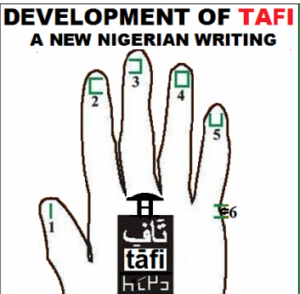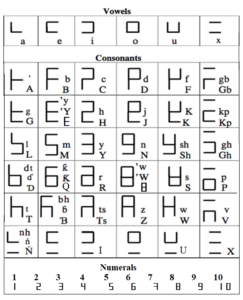For several centuries, the Hausa language of Nigeria has generally been written in the Ajami and Boko scripts–Ajami being developed from the Arabic alphabet and Boko from the Latin. The Tafi alphabet, created around 1970, aims to retain the best features of both scripts.
The word “Tafi” is taken from the last two syllables of the Hausa word lit-tafi, meaning “book.” With a different intonation, it also means “palm of the hand” or “clapping of the hand.” The choice of words is significant: Tafi is described as a digital alphabet not in the customary modern sense but in an older one—it is based on the human hand. To cite the Tafi website:
“Tafi is a digital (of the fingers) writing (digitography) where the 36 letters of the alphabet are built from only 6 signs called digits… formed by joining 6 digits in twos, bottom to top. The digits, representing fingers of the hand, stand as the vowels: a, e, i, o, u and x.” (The sixth is represented by the point on the edge of the hand where the little finger meets the palm.)

Many indigenously-designed African scripts are intended for not just one local language but all African languages; Tafi has even more universal ambitions. “Tafi [letters] have been produced for English, Hausa, Igbo and Yoruba. Extra vowels, consonants and signs [for tones and vowel lengths] are provided, in a Universal Tafi Alphabet, to cater for the other languages of the World.”
It is also intended to be universal in terms of who can learn or use it. “Tafi is easy to learn by children and adults, with the objective of home teaching. It is adaptable for the blind to ‘read’ by touching, for the deaf and dumb to ‘feel’ through tapping and for sign-language, signal codes or musical beats.”

Update June 2023:
Musa D. Abdullahi reports: “We are collecting materials for teaching Tafi. We made a collection of 316 Aesop Fables in English and translated them into Hausa. We have transcribed the Fables in the Tafi Alphabet from the fonts built.”
As for teaching the script, he continued, “We started with a selection of 20 students in a Local Education Authority Primary School, in Katsina, on a private arrangement with the Headmaster.